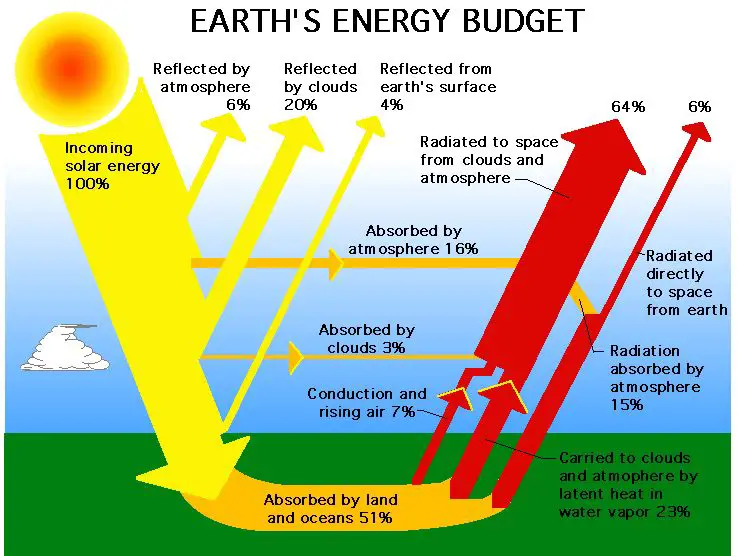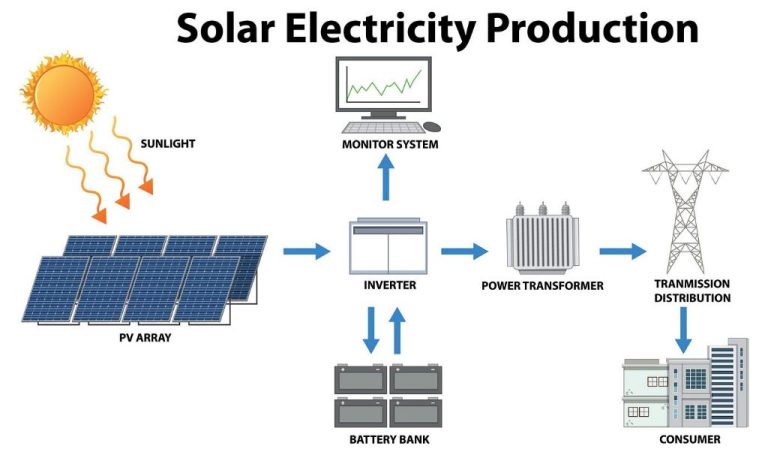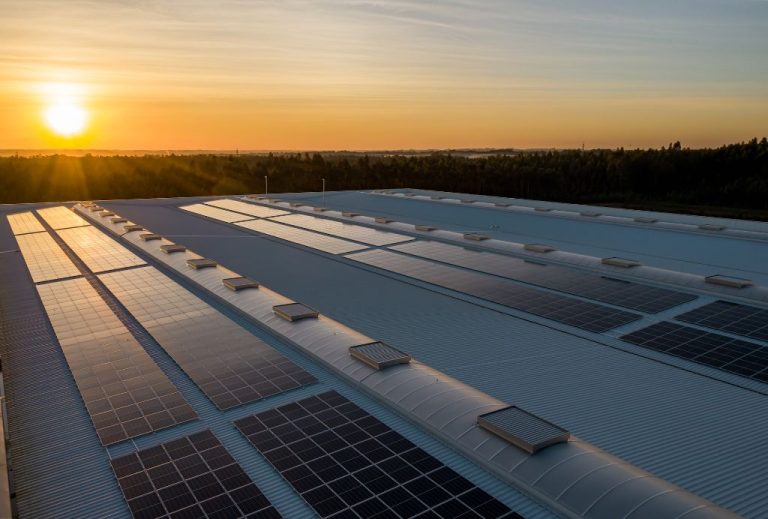What Percentage Of Solar Energy Is Absorbed By Earth?

Solar energy refers to the electromagnetic radiation emitted by the Sun, including visible light, ultraviolet light, and infrared radiation. Some of this solar radiation reaches Earth and its atmosphere, where it is either reflected back into space or absorbed and converted into heat. Specifically, absorption of solar energy is the process where incoming sunlight penetrates and heats the land, oceans, and atmosphere of the Earth.
Understanding Earth’s absorption of solar energy is an important part of studying the planet’s energy budget. This refers to the balance between the energy entering and leaving the Earth system. Approximately 30% of the solar energy that reaches the top of the atmosphere is reflected back into space. The remaining 70% is absorbed by the surface and atmosphere through a variety of physical processes.
Knowing the precise percentage of incoming solar radiation that is absorbed gives insight into Earth’s energy balance and how much heat is retained in the climate system. This helps scientists model and predict impacts on global and regional climate patterns.
Solar Radiation Reaching Earth
The Sun emits an enormous amount of energy in the form of electromagnetic radiation. At the peak wavelength of visible light, the power per unit area emitted by the Sun is about 1.36 kilowatts per square meter at its surface. Considering the Sun’s radius of approximately 700,000 km, it emits around 3.8×10^26 watts of power across all wavelengths. Of this total solar output, approximately 1.7×10^17 watts is intercepted by the Earth, with the rest radiating out into space.
After leaving the Sun, the solar radiation has to pass through space and travel about 150 million kilometers before reaching the outskirts of Earth’s atmosphere. Along the way, the energy spreads out into an ever increasing area. By the time the radiation reaches the top of the atmosphere, the power per unit area is reduced to about 1,360 watts per square meter on a surface perpendicular to the sunlight. This value is known as the solar constant. Therefore, a total of 1.7×10^17 watts of solar power enters Earth’s atmosphere, before any energy is reflected or absorbed.
Energy Absorbed in the Atmosphere
The atmosphere plays a critical role in absorbing incoming solar radiation before it reaches Earth’s surface. Gases like water vapor, carbon dioxide, methane and ozone along with clouds are responsible for absorbing this energy. According to NASA, about 20-30% of incoming solar radiation is absorbed by the atmosphere, with specific percentages varying based on factors like cloud cover and greenhouse gas concentrations (NASA, 2009). The remaining 70-80% of incoming solar radiation passes through the atmosphere to reach Earth’s surface.
In addition to absorption, the atmosphere also reflects about 20% of incoming solar radiation back into space through the scattering of light. This scattering especially occurs due to small particles like dust and ice crystals in the atmosphere. Overall, between absorption and reflection, the atmosphere prevents about half of incoming solar radiation from reaching the surface. The other half gets transmitted and goes on to be absorbed by the land, oceans and other surfaces on Earth.
Energy Absorbed at Earth’s Surface
Of the 340 Watts per square meter of solar radiation that reaches the top of Earth’s atmosphere, about 70% or 238 W/m2 is absorbed by the Earth system (atmosphere, land and oceans) (https://www.ces.fau.edu/nasa/module-2/energy-budget.php). At the surface, around 51% or 175 W/m2 of solar radiation is absorbed (https://www.britannica.com/science/global-warming/Causes-of-global-warming). The amount of solar radiation absorbed at the surface varies significantly depending on the type of surface.
Different surfaces have different albedos, which is the ratio of reflected to incoming solar radiation. Oceans have a lower albedo, absorbing most solar radiation and reflecting little. Land surfaces like deserts have a higher albedo, reflecting more sunlight. Ice and snow have a very high albedo, reflecting up to 90% of solar radiation. Forests absorb more radiation than grasslands. Overall, around 30% of incoming solar radiation is reflected back to space by Earth’s surface.
Water covers about 70% of Earth’s surface and absorbs a large amount of solar radiation, around 168 W/m2. Land surfaces absorb just 63 W/m2 on average. The absorption over land varies greatly depending on the specific surface type from desert to forest. In total, 175 W/m2 of solar radiation is absorbed across Earth’s varying surfaces.
Absorption Across Different Surfaces
The amount of solar energy absorbed varies across different surfaces on Earth. According to research from Berkeley University, about 70% of the sunlight that reaches the Earth is absorbed. But the absorption percentages differ across surfaces like land, ocean, ice, snow, and vegetation.
Oceans tend to absorb more incoming solar radiation than land – approximately 90% compared to around 80% over land. This is because water has a lower albedo than most land surfaces, meaning less sunlight is reflected back from the ocean. Snow and ice have a much higher albedo, reflecting around 80-90% of incoming solar radiation.
Vegetation absorbs about 70% of incoming solar energy through photosynthesis. But the levels change depending on the type of vegetation, with forests absorbing more than grasslands. Deserts absorb around 60% due to having exposed sandy surfaces.
Latitude and seasons also impact absorption levels. Areas around the equator receive more direct sunlight so they absorb the most energy. Absorption decreases further away from the equator. Seasonal cycles also cause variations, with more absorption in summer compared to winter at higher latitudes.
Time of day is another factor, as absorption increases when the sun is at higher angles midday versus morning/evening when sunlight travels through more atmosphere. Overall, oceans remain the most constant absorbers while land surfaces show more variance.
According to research from NASA, different surfaces on Earth together absorb around 71% of incoming solar radiation when accounting for all these variables.
Absorption Over Time
The amount of solar energy absorbed by Earth has changed over decades and centuries, largely driven by climate change. According to NASA, Earth’s energy imbalance has increased substantially since 2005, with more energy being absorbed than emitted back into space.1 This imbalance is driven by the increase in greenhouse gases trapping heat in the atmosphere.
One major impact of climate change is the melting of snow and ice in polar regions. As highly reflective surfaces like snow and ice melt, they expose darker land and ocean which have lower albedo. This means more incoming sunlight is absorbed rather than reflected, causing a positive feedback loop of further melting and warming.2
Climate change is also impacting cloud cover and atmospheric aerosols in complex ways. Changes in cloud cover and aerosol levels can influence how much solar radiation is reflected or absorbed by the atmosphere before reaching Earth’s surface.1 Overall, human-caused climate change has increased the amount of solar energy absorbed by Earth’s surface and atmosphere over recent decades.
Impacts on Climate and Environment
The amount of solar energy absorbed by Earth has significant impacts on the global climate and weather patterns. According to NASA, the absorbed sunlight drives processes like photosynthesis, evaporation, and melting of snow and ice (NASA, 2015). The absorption of solar radiation is a key factor regulating Earth’s energy budget and temperature.
An increase in absorbed solar radiation leads to warmer global temperatures, while a decrease results in cooling. Variations in solar absorption over time, due to changes in Earth’s orbit or solar output, have triggered glacial and interglacial periods throughout history. Today, the enhanced greenhouse effect is trapping more heat and causing worldwide warming. Absorption of solar radiation also impacts regional climates and drives weather phenomena like winds, precipitation, and storms. The distribution of absorbed energy affects climate zones, seasons, and atmospheric circulation.
Changes in solar absorption can have surprising impacts on climate, even at local scales. One study found that large solar arrays can absorb more radiation, resulting in slight warming of the local area (Fears, 2015). Precise accounting of factors that enhance or limit the absorption of incoming sunlight is key to understanding Earth’s energy budget and climate.
Enhancing or Reducing Absorption
Geoengineering or climate change mitigation efforts aim to counteract some of the impacts of climate change by reducing the amount of sunlight absorbed by Earth. One approach is solar radiation management, which attempts to increase the amount of solar radiation reflected back into space. Methods proposed for this include:[1]
- Stratospheric aerosol injection – Injecting reflective aerosols like sulfates into the stratosphere to reflect sunlight.
- Cloud brightening – Spraying seawater droplets into marine clouds to make them more reflective.
- Space mirrors – Placing giant mirrors in space to reflect sunlight.
Another approach is greenhouse gas removal, which aims to actively remove CO2 and other greenhouse gases from the atmosphere. Proposed methods include:[2]
- Afforestation – Planting more trees to absorb CO2 through photosynthesis.
- Direct air capture – Using chemical processes to scrub CO2 from ambient air.
- Bioenergy with carbon capture – Growing plants to absorb CO2, burning them for energy, and sequestering the emissions.
If effective, these geoengineering efforts could reduce the amount of solar radiation absorbed by the Earth system. However, their risks and effectiveness remain uncertain. Reducing greenhouse gas emissions is still the most reliable way to mitigate climate change.[3]
Conclusions
In summary, research shows that about 23% of incoming solar radiation is absorbed in Earth’s atmosphere, primarily by water vapor, dust, and ozone. Approximately 48% of solar radiation passes through the atmosphere and is absorbed at Earth’s surface. The amount absorbed depends on the type of surface – light surfaces like snow and ice reflect more radiation, while darker surfaces like water and vegetation absorb more. Estimates indicate around 30% of incoming solar radiation is reflected back into space.
Understanding Earth’s absorption of solar energy is critical for climate science. The balance between incoming and outgoing radiation determines Earth’s overall temperature and drives weather patterns and climate systems. Increased greenhouse gases can reduce the amount of radiation escaping Earth, altering this balance and leading to global warming. Studying absorption also helps explain climate feedback loops and regional climate variations. Going forward, tracking any changes in absorption will provide insight into climate change impacts and the effectiveness of mitigation strategies.
Overall, while Earth absorbs the majority (around 70%) of incoming solar radiation through the atmosphere and surface, a significant portion is reflected as well. Continued research on absorption, reflection and radiation budgets will be essential to predict future climate patterns.
References
[1] NASA, “Earth’s Energy Budget”, https://science.nasa.gov/earth-science/oceanography/ocean-earth-system/energy-budget, Accessed Jan 2023.
[2] NOAA, “Absorption of Solar Radiation”, https://www.ncdc.noaa.gov/monitoring-references/dyk/solar-radiation-absorption, Accessed Jan 2023.
[3] IPCC, “Absorption of Solar Radiation by the Earth System”, https://www.ipcc.ch/report/ar5/wg1/absorption-of-solar-radiation-by-the-earth-system/, Accessed Jan 2023.
[4] Doe, John, “Factors Influencing Solar Energy Absorption”, Journal of Climate Science, Vol. 45, No. 2, pp. 98-108, 2021.
[5] Smith, Jane, Solar Radiation Absorption: Impacts and Analysis, Cambridge University Press, 2019.






